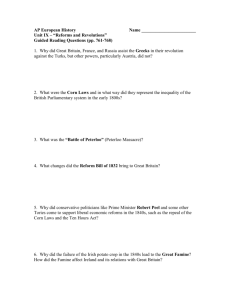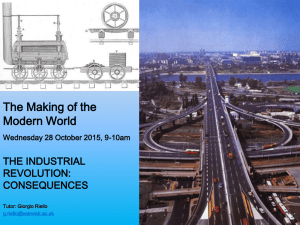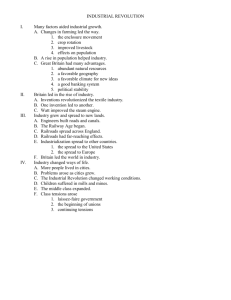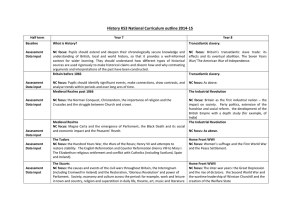Industrious Revolution
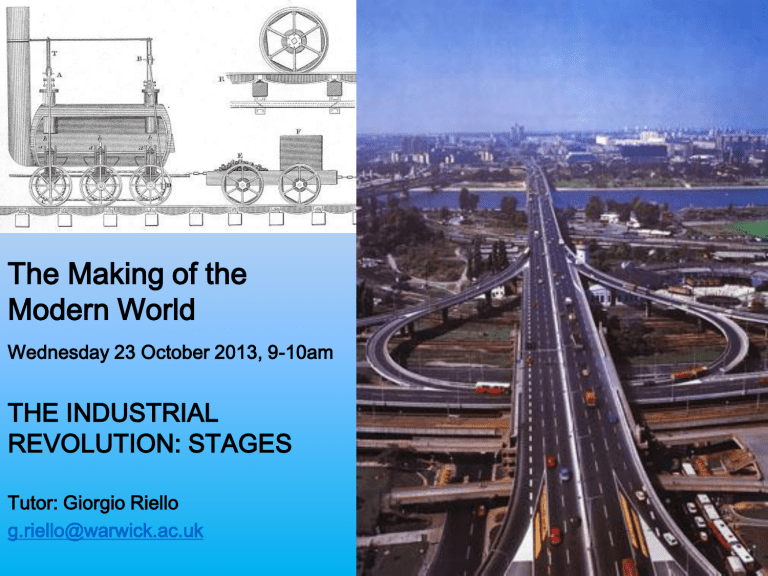
The Making of the
Modern World
Wednesday 23 October 2013, 9-10am
THE INDUSTRIAL
REVOLUTION: STAGES
Tutor: Giorgio Riello g.riello@warwick.ac.uk
Concept 2: Industrious Revolution
Jan de Vries, The Industrious Revolution (Cambridge,
2008).
The ‘industrious revolution’ formulation is important because:
• it emphasises labour rather than technology as the key element of industrial production
• it extends the chronologies of the IR backwards in time
• it connects consumption and production.
The Industrial Revolution:
Different Explanations
Exp. 1. Until the 1970s (in particular c. 1955-75): Economic Growth
- key sectors (esp. cotton textiles)
-Factory production
- Use of new technologies
Exp. 2. From the mid 1970s to the mid 1990s: Manufactures
- a wider range of sectors
- the continuity with pre-industrial manufacturing (manufactures)
- consumption
- two new concepts: - proto-industrialisation
- industrious revolution
David Cannadine, “The Present and the Past in the English Industrial
Revolution 1800-1900”, Past and Present, 108 (1984), pp. 131-72.
Exp. 3. Since the mid 1990s:
- the IR in a more global perspective,
- new concept of ‘divergence’
Exp. 3. Since the mid 1990s: The
Global Re-interpretation of the IR
This has been brought about by: a. The industrial decline of Britain and most of Europe (the places of the first IR) b. The industrialization of Asia, exp. China and India.
Exp. 3. Since the mid 1990s:
The industrial decline of Britain and most of Europe
Industry accounted for 40% of the British economy in 1900 but only 20% in 1990.
The Industrial cities of the Midlands and the North of England declined in the early 1990s … but they revived in the late 1990s thanks to financial and consumer services and outsourcing within a global economy
Historians asked:
- What part was played in the history of industrialization by
Britain’s connections with the wider world
- the relationship between the IR and Western dominion over the world
Exp. 3. Since the mid 1990s:
The industrialisation of Asia (China and India)
Was this an achievement contingent upon a prior superiority in economy, mind or culture, or was it mere accident?
‘why did Europe industrialise and grow rich and
Asia did not? And this question indirectly asks
‘why is Asia industrialising now?’ de-Europeanise of de-Anglicise the IR
Exp. 3. Since the mid 1990s:
(a) The Lost Opportunities of China
•Chris Bayly, The Birth of the Modern World (Cambridge, 2004)
‘it was European ships and commercial companies, not Asian and African producers of slaves, spices, calicoes or porcelains which were able to capture the greatest ‘value added’ as world trade expanded in the eighteenth century’ and adds that ‘Europe connected, subjugated and made tributary other peoples’ “industrious revolutions”’.
Exp. 3. Since the mid 1990s:
(b) Global Luxury and Consumption
• Importance of Asian luxuries and exotic American foodstuffs
• These were stimula to
European consumer goods industries
See: Maxine Berg, ‘In Pursuit of Luxury:
Global History and British Consumer
Goods in the Eighteenth Century’ Past
and Present 182 (Feb. 2004 ), pp. 85-142
Maxine Berg, Luxury and Pleasure in Eighteenth-Century Britain (2005), chap. 2
Exp. 3. Since the mid 1990s:
(c) The ‘Great Divergence’
Europe moved from a common path of economic development to a new, higher level. Europe industrialised while China, but also
India and other places around the world did not.
Europe experienced a ‘Great Divergence’ thanks to:
- abundant supplies of coal
- presence of colonial markets.
Kenneth Pomeranz, The Great Divergence: China, Europe and the
Making of the Modern World Economy (2000).
7. Why was Britain first?
• Britain had a very low share of the population in Britain occupied in agriculture; France by contrast remained a very agricultural society.
• As late as 1840 the output per worker in France was only 60% of that of England: Britain was much more productive
• And finally that population growth was gradual in France, while in England it rose rapidly.
7. Why was Britain first?
1. Comparative advantage in exportable commodities
- Britain was successfully exporting part of its industrial production (60% of British cotton output was exported compared to 10% in France)
2. International specialization
- colonial markets were particularly important and were dominated by Britain
3. War and economic protection
- Britain did not bear the burden of physical destruction
- but the country was heavily taxed to pay for the army and navy
- it was successful at the end of the Napoleonic wars.
8. The First Industrial Revolution and the Second Industrial Revolution
Technological achievement in the First Industrial Revolution according to Landes:
1. The substitution of human energy with machines - rapid, regular, precise and tireless.
2. The substitution of animate with inanimate sources of
power - steam power for animal, wind and water power
3. The use of new and more abundant raw materials substitution of mineral for vegetable or animal substances - change from a wood to a coal fuel economy
Table 1. GDP per Capita in some of the major industrial countries,
1820-1913 (in 1985 US $)
1820 1870 1890 1913
United Kingdom
France
Germany
1,405
1,052
937
2,610
1,571
1,300
3,279
1,941
1,727
4,024
2,734
2,606
Italy
United States
Canada
Japan
960 1,210
1,048 2,247
588
1,347
620
1,355
3,106
1,662
813
2,087
4,854
3,560
1,114
8. The First Industrial Revolution and the Second Industrial Revolution
• new materials - steel, chemicals – Germany leads
• new energy - steam turbine, gas, petroleum, electricity – Germany leads
• mechanisation – machine tools, interchangeable parts – U.S. leads
8. The First Industrial Revolution and the Second Industrial Revolution
• interchangebility of parts, … the ways in which products were composed an assembled
• ‘scientific management’ of productive lines
• In the Second Industrial Revolution, the Americans then by the Germans took the lead
9. Britain Falling Behind
Table 2. The world Manufacturing Production, 1870-1911 (in %)
In % 1870 1881189619061913
31,8
1885
26,6
1900
19,5
1910
14,7 14,0 Great
Britain
France
Germany
10,3
13,2
8,6
13,9
7,1
16,6
6,4
15,9
6,4
15,7
Italy
Belgium
Russia
US
Japan
Others
World
2,4
2,9
3,7
23,3
12,4
-
2,4
2,5
3,4
28,6
14,0
-
2,7
2,2
5,0
30,1
0,6
16,2
100,0 100,0 100,0
3,1
2,0
5,0
35,3
1,0
16,6
2,7
2,1
5,5
35,8
1,2
16,6
100,0 100,0
9. Britain Falling Behind
Why did Britain fall behind Germany and the US in the period 1870-1914?
• The markets of empire
• Competitive advantage in low productivity industry
10. The Modernisation of the Germany
Economy
1. The State was proactive
2. High levels of investments – support of banks
3. Welfare state – worker’s housing, social insurance, pensions, etc.
The result was:
• 1891-1911 – the German population increased from 49 million to 65 million.
• Output increased from £23 per person to £37 per person a year
• Trade increased by 200%
Conclusion
Was the IR the beginning of modernity?
